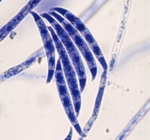


Plant pathogenic fungi represent serious economic threats. These organisms are rapidly adaptable, with plastic genomes containing many variable regions and evolving rapidly. It is, therefore, useful to characterize their genetic regulation in order to improve their control. One of the steps to do this is to obtain omics data that link their DNA structure and gene expression.
In this paper, Clairet et al. (2022) studied the nucleosome positioning and gene expression of four plant pathogenic ascomycete species (Leptosphaeria maculans, Leptosphaeria maculans 'lepidii', Fusarium graminearum, Botrytis cinerea). The genomes of these species contain different compositions of transposable elements (from 4 to 30%), and present an equally variable compartmentalization. The authors established MNAse-seq and RNA-seq maps of these genomes in axenic cultures. Thanks to an ad-hoc tool allowing the visualization of MNA-seq data in combination with other "omics" data, they were able to compare the maps of the different species between them and to study different types of correlation. This tool, called MSTS for "MNase-Seq Tool Suite", allows for example to perform limited analyses on certain genetic subsets in an ergonomic way.
In the fungi studied, nucleosomes are positioned every 161 to 172 bp, with intra-genome variations such as AT-rich regions but, surprisingly, particularly dense nucleosomes in the Lmb genome. The authors discuss the differences between these organisms with respect to this nucleosome density, the expression profile, and the structure and transposon composition of the different genomes. These data and insights thus represent interesting resources for researchers interested in the evolution of ascomycete genomes and their adaptation. For this, and for the development of the MSTS tool, we recommend this preprint.
References
Clairet C, Lapalu N, Simon A, Soyer JL, Viaud M, Zehraoui E, Dalmais B, Fudal I, Ponts N (2022) Nucleosome patterns in four plant pathogenic fungi with contrasted genome structures. bioRxiv, 2021.04.16.439968, ver. 4 peer-reviewed and recommended by Peer Community in Genomics. https://doi.org/10.1101/2021.04.16.439968
DOI or URL of the preprint: https://doi.org/10.1101/2021.04.16.439968
Version of the preprint: 1
Based on the comments of the two reviewers, I recommend that the authors correct and respond to the main suggestions highlighted in the reviews.
All the best,
Comments on Clairet et al., "Nucleosome patterns in four plant pathogenic..."
in this preprint authors present the analysis of nucleosome occupancy on four plant pathogenic fungi and discuss several factors that might underlie the observed patterns. Authors developed a freely available bioinformatics workflow to analyse and plot nucleosome phasing data that might be of interest to other researchers. The MNase-seq datasets could be reused for larger comparative nucleosome occupancy studies. I think, however, that the preprint is spare on technical details and overinterpret the results in some parts. Below I detail my general comments, point to specific aspects that I would like to see addressed and finish with some minor corrections/clarifications. I hope authors find the comments useful and are willing to address the points raised.
General
1. The bioinformatics workflow is hardly described at all, thus leaving out some important details. These include both plotting parameters used in the different parts of MSTS and statistical choices. For instance,
2. Some figures appear as a patchwork, with mixed framed and not-framed plots (e.g. figures 3 and 4), clipped ranges (e.g. figure 3C), inconsistent legend and inset position. I also think the choice of presenting dinucleotide frequencies in different scales is misleading (e.g. representation belies that values for dinucleotides involving C and G are lower in three species, in Botrytis values ranged from 0.176 to 0.181 for dinucleotides involving C and G but from 0.313 to 0.321 for dinucleotides involving A and T). Why the Rorschach-like plots (figure a5) are not strictly symmetrical? In general smoothed lines in phaseogram plots should be made thicker and the chromosome boundaries in figures 2 and 3 represented as gaps rather than vertical lines.
Specific points
Minor points and proofreading (suggested changes in upper case)
p1, abstract: spell out MSTS, e.g. "we developed the tool MSTS (FOR MNASE-SEQ TOOL SUITE)" or "we DEVELOPED MNASE-SEQ TOOL SUITE (MSTS)"
p1, introduction: comparing fungi (an entire Kingdom) with Insects (a class within the kingdom Animalia) is unfair. I think equating number of named species with biodiversity is misleading for a number of factors (size of the community studying them, research effort, inconsistent species delimitations practices across disciplines, etc)
p2, first paragraph: "important damages in agriculture, human health, and THE environment" ... "and facilitate infection. EFFECTORS CAN BE small proteins"
p2, first paragraph: Add references to the statement "Upon plant infection, fungi undergo a tightly controlled transcriptional reprogramming..."
p2, first paragraph: how can we speak of "plastic regions" for genomes with "overall large proportion of TE evenly distributed throughout the genome"?
p2, first paragraph: please cite the "several recent studies (pointing) out the potential role of chromatin remodelling" instead of the 6-10 years old reviews
p2, second paragraph: "hemiascomycetous yeasts. NO comparative genome-wide analyses"
p2, third paragraph: "four different plant pathogenic fungi ASCOMYCETES showing"
p3, second paragraph: "micrococcal nuclease digestion of mono-nucleosomes COUPLED WITH HIGH-THROUGHPUT SEQUENCING (MAINE-seq or MNase-seq)"
p3, second paragraph: not sure to which "contrasted media" authors refer to. Only one media per species was used.
p5, second paragraph and elsewhere: homogenize the abbreviation of use of micrococcal nuclease digestion of mono-nucleosomes coupled with high-throughput sequencing
p5, third paragraph: can you comment on whether the estimated linker lengths (14 to 25 bp) are within what's known for other fungi?
p6, second paragraph: "plants and other higher eukaryotes'', really? "higher" to what?
p7, second paragraph: "regions equally packed with nucleosomes are interspaced with AREAS with lower density"
p8, second paragraph: "previously described ~10 bp-periodicities", previously described where?
p10, third paragraph: "when the analysis is restricted to CONSERVED fungal genes". Mind what "culture conditions" are not a factor here as they are linked to the species.
p21, figure 4 legend: add the reference of Laurent et al. (2017) to explain how "TE and AT-rich regions" were defined